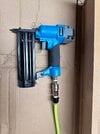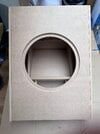AndreNewman
Prominent Member
Hi all,
I am starting to prepare for the box build. Overall shape is still up in the air as I am undecided on the layout and styling for the room. I may well revert to a more traditional cuboid shape.
I have a question on build material for the box. I know @IWC Dopplel used marine ply for his boxes and believe that MDF is typically used. Non-structural ply is a similar price to MDF (both 18mm) but nicer to work with (less toxic dust). Is there a disadvantage to using that over MDF (not worrying about exterior finish)? MDF has a higher mass/density I believe so perhaps that makes it more inert?
I did only one speaker cab in MDF and it’s horrible, dust everywhere! I think the only reason to use MDF is cost, ply is so much nicer to work with.
Not much, they work really well, cabs are a little top heavy so maybe I would have chosen a wider shorter design but then cab resonance would be even lower and well into operating range.@AndreNewman - I was wondering if you'd had any new thoughts on your subs since you completed them and have been using them?
I can post the cutlist I was sent when I get chance, have been on holiday and now off on work travel until the end of the month.I re-read your thread the other day looking for dimensions / box volume but couldn't seem to locate them. Would you mind sharing them here for me please?
General gist is 600x600mm double 18mm baltic ply baffle and single back panel. 334x600mm side panels and 334x640mm top and bottom.
Bracing was 275x600mm x 2 with 275x180mm spacers.
Side and top bottom panels are oversized to allow router trim for when the gluing isn’t perfect…
Internal is 99L so about 85-90L when bracing and driver is taken out.
If I wasn’t depth constrained I’d make the baffles smaller and the depth deeper, the back of the driver is a bit constrained, the bracing could be simpler and a great deal easier to glue up if the box was a bit deeper.
In short don’t copy my design unless you have my constraints. Copy markymiles for a simpler to build deeper box at the same volume.













